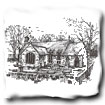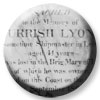Duff of Muldavit - A PUZZLING ENIGMA
 Cullen Old Kirk has several memorials, which were purposely vandalised and altered in the late 18th century for the reputed genealogical benefit of James, second Earl of Fife. The reasons behind these alterations can at best be described as historically naive in the extreme, and at worst, down right absurd. They range from the destructive removal of text in St Ann’s Chapel (south aisle), to the apparent crudely effected part re-wording of the inscription on the large grave-slab beside the north entrance. This memorial also includes a fascinating enigma in respct of the very strange figure of a man carved into its worn surface. At first glance the readable information on the stone suggests it was dedicated to John Duf of Maldavat & Baldavi who died on the 2nd July, 1404. However, William Cramond, Cullen’s 19th century noted historian, recorded the remainder of the visible text, which appears to show quite clearly that the original memorial inscription was dedicated to Alexander Innes.
Cullen Old Kirk has several memorials, which were purposely vandalised and altered in the late 18th century for the reputed genealogical benefit of James, second Earl of Fife. The reasons behind these alterations can at best be described as historically naive in the extreme, and at worst, down right absurd. They range from the destructive removal of text in St Ann’s Chapel (south aisle), to the apparent crudely effected part re-wording of the inscription on the large grave-slab beside the north entrance. This memorial also includes a fascinating enigma in respct of the very strange figure of a man carved into its worn surface. At first glance the readable information on the stone suggests it was dedicated to John Duf of Maldavat & Baldavi who died on the 2nd July, 1404. However, William Cramond, Cullen’s 19th century noted historian, recorded the remainder of the visible text, which appears to show quite clearly that the original memorial inscription was dedicated to Alexander Innes.
When The Moray Burial Ground Research Group came to record all the memorials at the Old Kirk in 2012, members almost immediately became ‘hooked’ with considerable fascination, over the appearance of this strange carving. My very first personal impression of this image was that it looked as if it rightly belonged in the cast of an episode of ‘Dr Who’! However, it is very interesting to note that this carving has provoked professional but diverging opinions as to its composition and quality of carving. On the one hand it has been dismissed out of hand as having been carved by ‘the local idiot,’ On the other side of the discussion, the artwork has recently been described as ‘definitely the line work of an academically trained artist of the later ninteenth century.’ Which argument is correct?
In 1792, The Earl of Fife removed the slab along with the recumbent figure to the Duff Mausoleum in the grounds of Duff House, Banff where they remained for some 174 years. After a great deal of thought and consderable effort, these memorials were returned to the kirk in 1966, although for many years the grave slab stood outside in all weathers against the kirk wall. Not long ago the slab was moved inside for protection, and indeed this was an excelent decision, as unfortunately the effects of coastal weathering has effected considerable wear on the stone surface.
Over the last year we have collected as much data as possible about these two memorials, and this included a recent visit to Duff House to view where both had rested for so many years. Luckily we are now in possession of a copy black and white photograph of the grave slab taken not long after its return to the church. As a result we are now able to put forward a number of new theories about various aspects relating the history of this important monument. For example, it is possible that the turbaned figure might represent the third image to be carved on its worn surface.
Investigations are still ongoing and any information, theory, comment or suggestion relating to these memorials is most welcome. For further information please contact enquiries@mbgrg.org.
As information has come to light from at least the days of Cullen’s noted historian, William Cramond in the 19th century, it has been suggested, not without good reason, that James Duff, Earl of Fife, purposely vandalised and altered several important memorial inscriptions in Cullen Old Kirk. That he did so as a potential aid in proving his family’s historic antiquity, seems at best to be considered naive in the extreme, and at worst, down right absurd.
Article: Courtesy of Keith Mitchell








